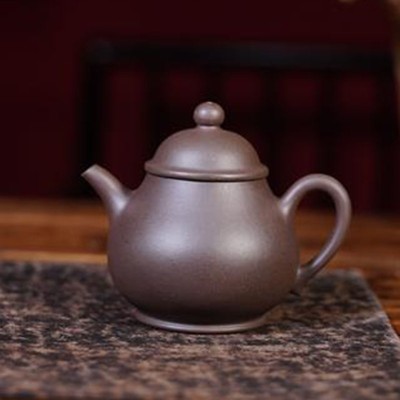







A flattened persimmon-shaped teapot is called a "Short Pan," a slightly taller and flattened spherical-shaped teapot is called a "Medium Pan," and a teapot with a taller and pear-shaped body is called a "Tall Pan." When their daughters got married, they would give a Pan teapot as part of their dowry, hoping that their daughters would be able to live a prosperous life like "Pan Shicheng" who the inventor of the "pan" teapot. teapots that are passed down as part of the dowry are not necessarily used for brewing tea, but can also be placed on dressing tables to hold hair oil. After the female owner passes away, they are often used as burial objects to show gratitude to her family for raising her.
 Delivery
Delivery
Free shipping within 1 to 3 days. ETA:5-7 days
 Returns
Returns
Within 28 days after delivery date.
 Security
Security
SSL | GDRP used to ensure information security.
Guarantee safe & secure checkout
Data sheet
This yixing teapot is amazing! The color is beautiful and it feels so comfortable in my hands. It really enhances the flavor of the tea
A flattened persimmon-shaped teapot is called a "Short Pan," a slightly taller and flattened spherical-shaped teapot is called a "Medium Pan," and a teapot with a taller and pear-shaped body is called a "Tall Pan." When their daughters got married, they would give a Pan teapot as part of their dowry, hoping that their daughters would be able to live a prosperous life like "Pan Shicheng" who the inventor of the "pan" teapot. teapots that are passed down as part of the dowry are not necessarily used for brewing tea, but can also be placed on dressing tables to hold hair oil. After the female owner passes away, they are often used as burial objects to show gratitude to her family for raising her.
A flattened persimmon-shaped teapot is called a "Short Pan," a slightly taller and flattened spherical-shaped teapot is called a "Medium Pan," and a teapot with a taller and pear-shaped body is called a "Tall Pan." When their daughters got married, they would give a Pan teapot as part of their dowry, hoping that their daughters would be able to live a prosperous life like "Pan Shicheng" who the inventor of the "pan" teapot. teapots that are passed down as part of the dowry are not necessarily used for brewing tea, but can also be placed on dressing tables to hold hair oil. After the female owner passes away, they are often used as burial objects to show gratitude to her family for raising her.
"Lianzi" means Lotus Seed, "lianzi" family has various shapes and forms, which reflects the Buddhist saying "Lotus originates from the heart, and the heart gives rise to infinite forms." the shape of the Lotus Seed was characterized by a straight mouth, drooping shoulders, circular feet, and a round and bulging body with a slightly bulging cover, resembling a lotus seed. Over time, the design evolved from being simple and rustic to being elegant and graceful, with the lid raised and adorned with a bead knob, making it look more towering. A small spout gracefully protrudes from the shoulder of the pot, while the handle is shaped like a woman's arm in a graceful and elegant stance.
"Fanggu" Yixing Teapot - This zisha teapot has an antique cylindrical body shaped like a drum, with a short neck imitating the shape of a drum pot. The spout is also designed to imitate the shape of a drum pot spout, with a straight line. Its advantages include excellent heat preservation, natural color, comfortable texture, and long service life. The "Fanggu" teapot is a unique and elegant choice for tea lovers and collectors alike.
As a shape, "Ruyi" is a common pattern and object shape in traditional Chinese culture,the "Ruyi" shape represents auspicious, happiness, and good meanings in Chinese culture.
"Shipiao" Yixing teapot- this zisha teapot is a traditional Chinese tea set characterized by its gourd-like or calabash-like shape, with a small top and large bottom, a sturdy and short spout, and a pyramid-shaped body that exudes elegance. Made from high-quality purple clay material, this teapot is known for its hardness and durability, as well as its stable and easy-to-use design. The short and powerful straight spout ensures a smooth and steady flow of water, while the pyramid-shaped body adds a touch of sophistication to any tea ceremony.
"Julun" yixing teapot- this "Julun" zisha teapot is designed for practicality, with a spout that ensures smooth water flow and a handle that is easy to grip. The lid is also uniquely designed for easy removal. Despite its distinctive and eye-catching appearance, the "Julun" teapot is a functional and practical utensil that is highly valued by tea enthusiasts for its ability to brew tea effectively and efficiently. Its unique shape allows tea leaves to fully expand, releasing more aroma and flavor. The name "JuLun" comes from its shape, which resembles an upside-down cartwheel. This teapot is not only aesthetically pleasing but also highly functional, making it a popular choice among tea lovers and collectors.
Gourd yixing teapot features a unique design. The shape resembles a gourd, with a short and slightly upward-curved spout and a half-circular handle. The lid is decorated with a loop-shaped knob. The overall design is characterized by smooth and rounded lines.
"Shipiao" Yixing teapot- this zisha teapot is a traditional Chinese tea set characterized by its gourd-like or calabash-like shape, with a small top and large bottom, a sturdy and short spout, and a pyramid-shaped body that exudes elegance. Made from high-quality purple clay material, this teapot is known for its hardness and durability, as well as its stable and easy-to-use design. The short and powerful straight spout ensures a smooth and steady flow of water, while the pyramid-shaped body adds a touch of sophistication to any tea ceremony.
"Duoqiu" yixing teapot is a classic example of a geometric-style traditional round teapot and one of the finest representatives of purple clay teapots. Its basic form consists of a pot knob, pot cover, and pot body, composed of small, medium, and large spheres arranged in sequence. The pot belly is a large sphere, and the pot cover is a small sphere, giving the appearance of a small ball placed on top of a large ball, hence the name "duoqiu" teapot. This unique design creates a visually striking and aesthetically pleasing teapot that is highly prized by collectors and tea enthusiasts alike.
"Duozhi" yixing teapot is a unique and distinctive shape in the world of Yixing zisha teapots. Its shape resembles a pile of spheres and hemispheres stacked together, giving it a unique and eye-catching appearance. The name "Duo Zhi" comes from the Chinese word for "stacking and linking." Due to its unique appearance, this type of teapot is commonly referred to as the "Duozhi teapot." Interestingly, the name "Duozhi" in Chinese also carries a positive connotation, meaning "many children, much happiness." This adds to the charm and appeal of this teapot, making it a popular choice for collectors and tea enthusiasts alike.
"Linghua" Yxing teapot is adorned with diamond-shaped patterns all over its body, with the lid seamlessly integrated into the design. The lid is composed of six petals that are symmetrically arranged, and the edges are sharply defined, creating a beautiful and charming appearance. The teapot design evolved from the Line Yun teapot, with the bridge handle blending in with the diamond petals. The spout is shaped like a diamond flower, with a natural curve that is easy to hold. A waistband is tied around the center of the teapot, and the diamond lines intersect perfectly from top to bottom. The lid can be rotated to fit securely on any of the six sides, showcasing the exquisite craftsmanship of this teapot.
"Shipiao" Yixing teapot- this zisha teapot is a traditional Chinese tea set characterized by its gourd-like or calabash-like shape, with a small top and large bottom, a sturdy and short spout, and a pyramid-shaped body that exudes elegance. Made from high-quality purple clay material, this teapot is known for its hardness and durability, as well as its stable and easy-to-use design. The short and powerful straight spout ensures a smooth and steady flow of water, while the pyramid-shaped body adds a touch of sophistication to any tea ceremony.
This teapot has a cute and silly appearance, so it's named "Han Piao".
Pear-shaped yixing teapot,it is one of the pot styles that originated in the Chian Yuan Dynasty and became popular during the China Ming Dynasty. It is named after its pear-like shape.
The design of the "Xubian" zisha teapot is a combination of the elements of the "Xubian" and the "Gongdeng". "Xubian" refers to the flat shape of the body of the pot, while "Gongdeng" refers to the shape of the lid of the pot, which is like a palace lamp. This design not only retains the characteristics of traditional purple clay pots, but also adds some new elements, making the "Biandeng" more ornamental and collectible.
The apple-shaped Yixing teapot is another unique example of zisha teapot. As the name suggests, it is designed to resemble an apple.
The Melon-shaped Yixing teapot is a classic example of the zisha teapot. It is characterized by its unique shape, which resembles some melon , and is made of purple clay, also known as zisha clay.
"Jizhi" yixing teapot has a straight cylindrical body with a shoulder, short neck, and straight spout. The handle is free-flowing and ear-shaped, while the lid fits tightly. The bottom of the pot is neatly crafted with exquisite workmanship. The overall design of the pot displays a strong contrast between thick and thin lines, as well as between straight and curved lines, giving it a deep, simple, and powerful temperament. At the same time, it also exudes a sense of elegance and grace. It seems that the "Jizhi" teapot conveys a spirit of honesty and justice, daring to advise others.
"Bafang"-The octagonal yixing teapot is a relatively rare type of square-shaped purple clay teapot. The lines and surfaces are straight, flat, and distinct, giving people a sense of cleanliness, sharpness, and elegance. The rules for creating a square-shaped teapot require "smooth lines, distinct contours, and a stable and solemn appearance," with straight and horizontal lines as the main elements, and curved and thin lines as the auxiliary elements. In addition to requiring symmetry between the mouth, lid, spout, handle, and body of the teapot, the square shape also requires "roundness within squareness, seeking change within the squareness, and uniformity between the mouth and lid, with a balance between rigidity and flexibility."
NOTICE : Cookies ensure the smooth running of our services and improve user experience,Using these, you accept the use of cookies. Learn More.